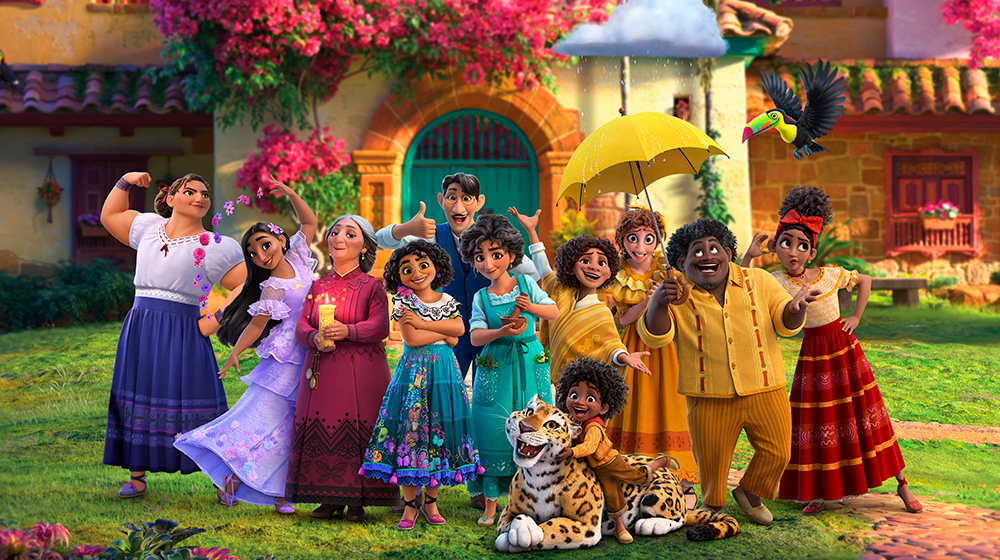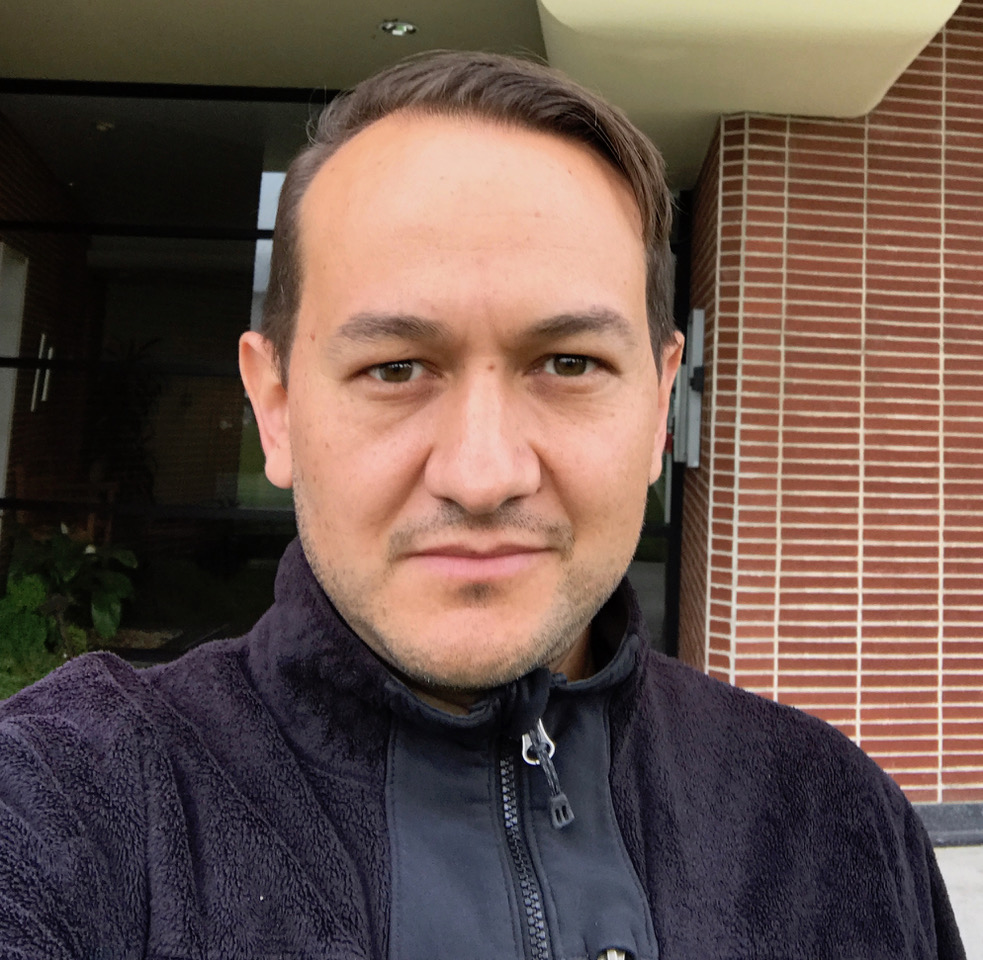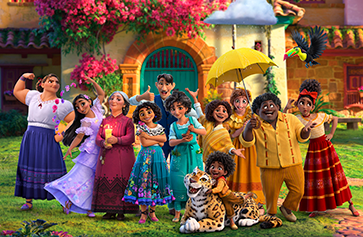UCLA botanist Felipe Zapata brings Colombia’s biodiversity to Academy Award winner ‘Encanto’

The outside walls of Colombian homes are commonly adorned with magenta-colored bougainvillea vines like those on the Madrigals’ house. Image courtesy of The Walt Disney Studios.
Felipe Zapata taps into his life’s work, as well as childhood memories, to give the animated film its distinctive flora
By Madeline Adamo

Felipe Zapata, Assistant Professor of Ecology and Evolutionary Biology at UCLA
Felipe Zapata can vividly recall driving from Bogota, where he grew up, to Colombia’s Cocora Valley as a child to spend holidays and summers with family. He remembers crossing the rugged terrain of the Andes mountains as well as the descent into the warmer valleys marked by coffee plantations and greener tropical plants with blooms of many colors. The sudden appearance of wax palms, the tallest palm tree in the world, would signal to Zapata and his family that their destination was near.
It was those drives and the beauty of Colombia’s biodiversity — which includes staples such as the platanilla, a close relative of the banana tree; guadua, a neotropical bamboo; the guayacán, a tree with yellow flowers similar in form to the purple jacaranda tree; the yarumo, an umbrella-like tree with impressive leaves; and the presence birds like the great kiskadee and the parrot — that inspired Zapata, an assistant professor of ecology and evolutionary biology in the UCLA College, to become a botanist.
What he didn’t expect was that his research and lived experiences would influence the distinctive landscapes of Walt Disney Animation Studios’ “Encanto,” a film that tells the tale of an extraordinary family, the Madrigals, who live hidden in the mountains of Colombia in a magical house adjacent to a vibrant town.
“Initially, it was going to be mainly about the wax palm,” said Zapata of his early advising on the film. But it quickly sprouted into much more. “All of a sudden it became an exploration of basically all the ecosystems in Colombia, and looking for key plants that you can identify and that they can easily draw.”

“There’s a kind of magic in these places,” said Felipe Zapata of the wax palms and cloud forests characteristic of the region where “Encanto” takes place.
Zapata, who specializes in the evolution of biological diversity, was soon bringing in his old field guides to familiarize filmmakers and artists with the region (also known as the country’s coffee region) and identifying birds, and native plants that people there would eat. Zapata enjoyed seeing some of his suggestions come to life in the film, from the herbs such as yerba buena and guasca that the character Julieta, who has the power to heal through food, wears in her apron, to the rendering of hummingbirds and toucans that frequent the vivid landscapes that provide part of the visual lushness of the film.
Zapata said he can’t choose one thing he’s most proud of, but that it might be how the representations of the wax palms and cloud forests set the tone for the film’s fantastical theme.
“There’s a kind of magic in these places,” said Zapata, whose Zoom background is wax palms and cloud forests on a cascading Colombian mountainside.
Zapata, who is also on the advisory committee of the UCLA Mildred E. Mathias Botanical Garden, said that he was initially contacted by Disney Animation after the garden’s former assistant director mentioned his name to Disney. The studio had asked if a Colombian researcher at UCLA could consult on biodiversity for the film.
Fast-forward about three years, and Zapata found himself sitting in the Hollywood premiere for “Encanto” among the filmmakers and stars such as Stephanie Beatriz (“Brooklyn Nine-Nine”), Diane Guerrero (“Orange is the New Black”), John Leguizamo (“Ice Age”) and María Cecilia Botero (“Enfermeras”). Also in the audience were members of the Colombian Cultural Trust, a group of Colombian experts who advised the filmmakers throughout the production.
“That was the first time that I saw the movie from beginning to end on a big screen, with the loud music and with multiple people from Colombia,” said Zapata, who is also a member of the UCLA Latin American Institute. “It was really, really exciting to see it.”
Members of the trust consulted on culture, anthropology, costume design, botany, music, language and architecture, as well as many other aspects of the film; the setting was inspired by the Cocora Valley in the early 20th century. Amongst the trust’s 10 members, Zapata was the only botanist.
“Encanto,” which has nabbed three Academy Award nominations, has made quite an impression on Zapata’s family back in Colombia, who went to see it in theaters after its November 2021 release, he said.
“They were so excited. My little cousins were looking for me in the movie — they thought that I was in it,” said Zapata, who was not able to talk about his role with the movie or in the Colombian Cultural Trust until after the film’s release.
Zapata said that filmmakers portrayed Colombia accurately, so much so that he got nostalgic when he saw the film for the first time. One of his favorite parts of the film, besides the complex narrative of the family, was seeing the small detail of the bamboo support beams within the walls of the Madrigals’ home. For Zapata, it evoked memories of the old houses he frequented during his memorable summers in the Cocora Valley.
Zapata, who was able to return home to Colombia last November, says that he’s happy to be able to share his line of work on such a creative platform.
“I always wanted to be able to engage the public and people who are not necessarily biologists,” Zapata said. “I was always looking for opportunities to do it, and this was amazing.”
This article originally appeared in the UCLA Newsroom. For more news and updates from the UCLA College, visit college.ucla.edu/news.


 Courtesy of The Walt Disney Studios
Courtesy of The Walt Disney Studios Amisha Gadani/UCLA
Amisha Gadani/UCLA Reed Hutchinson/UCLA
Reed Hutchinson/UCLA